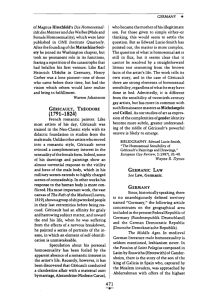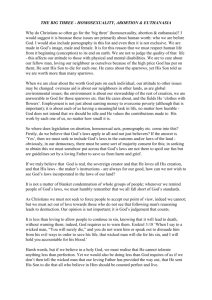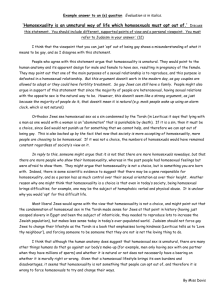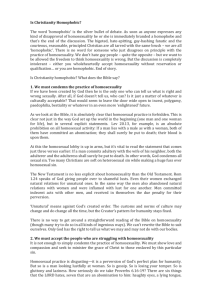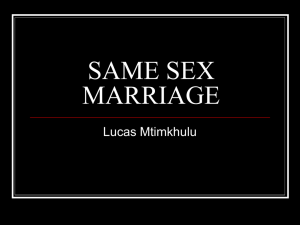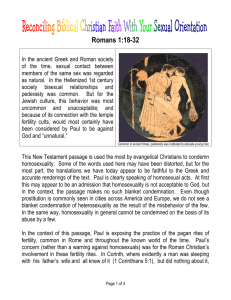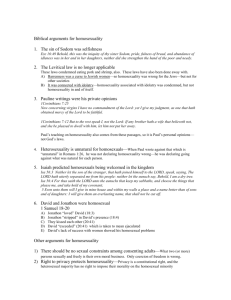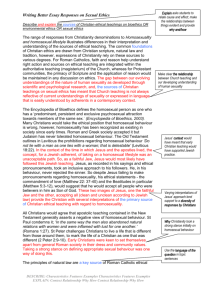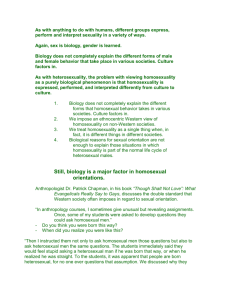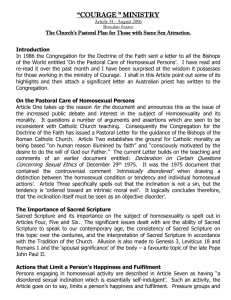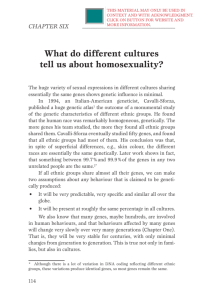Theories
advertisement
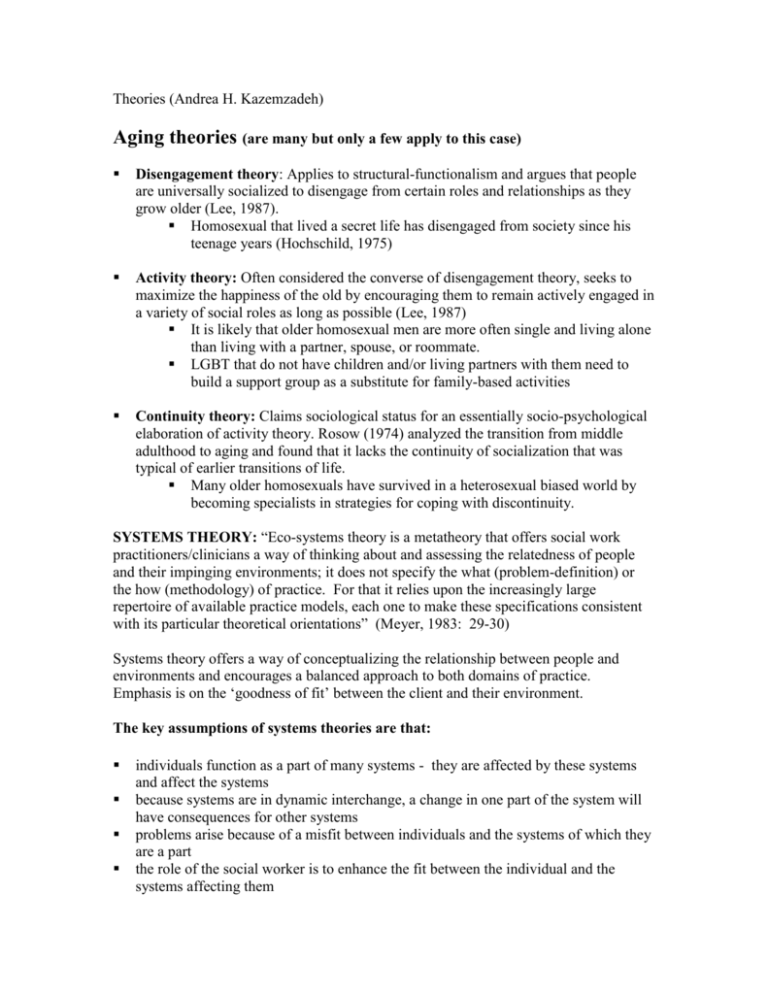
Theories (Andrea H. Kazemzadeh) Aging theories (are many but only a few apply to this case) Disengagement theory: Applies to structural-functionalism and argues that people are universally socialized to disengage from certain roles and relationships as they grow older (Lee, 1987). Homosexual that lived a secret life has disengaged from society since his teenage years (Hochschild, 1975) Activity theory: Often considered the converse of disengagement theory, seeks to maximize the happiness of the old by encouraging them to remain actively engaged in a variety of social roles as long as possible (Lee, 1987) It is likely that older homosexual men are more often single and living alone than living with a partner, spouse, or roommate. LGBT that do not have children and/or living partners with them need to build a support group as a substitute for family-based activities Continuity theory: Claims sociological status for an essentially socio-psychological elaboration of activity theory. Rosow (1974) analyzed the transition from middle adulthood to aging and found that it lacks the continuity of socialization that was typical of earlier transitions of life. Many older homosexuals have survived in a heterosexual biased world by becoming specialists in strategies for coping with discontinuity. SYSTEMS THEORY: “Eco-systems theory is a metatheory that offers social work practitioners/clinicians a way of thinking about and assessing the relatedness of people and their impinging environments; it does not specify the what (problem-definition) or the how (methodology) of practice. For that it relies upon the increasingly large repertoire of available practice models, each one to make these specifications consistent with its particular theoretical orientations” (Meyer, 1983: 29-30) Systems theory offers a way of conceptualizing the relationship between people and environments and encourages a balanced approach to both domains of practice. Emphasis is on the ‘goodness of fit’ between the client and their environment. The key assumptions of systems theories are that: individuals function as a part of many systems - they are affected by these systems and affect the systems because systems are in dynamic interchange, a change in one part of the system will have consequences for other systems problems arise because of a misfit between individuals and the systems of which they are a part the role of the social worker is to enhance the fit between the individual and the systems affecting them Principles of Systems Intervention the notion of partnership the worker facilitates change but is not an expert about the system sustained change non-judgmental holism and recognition of social connection Family Systems Theory (Bowen) This theory emerged from General Systems Theory by scholars who found it had many applications to families and other social systems. Any system is defined as a bounded set of interrelated elements exhibiting coherent behavior as a trait. (Constantine, 1986). Bowen family systems theory is a theory of human behavior that views the family as an emotional unit and uses systems thinking to describe the complex interactions in the unit. It is the nature of a family that its members are intensely connected emotionally. Often people feel distant or disconnected from their families, but this is more feeling than fact. Family members so profoundly affect each other's thoughts, feelings, and actions that it often seems as if people are living under the same "emotional skin." People solicit each other's attention, approval, and support and react to each other's needs, expectations, and distress. The connectedness and reactivity make the functioning of family members interdependent. A change in one person's functioning is predictably followed by reciprocal changes in the functioning of others. Families differ somewhat in the degree of interdependence, but it is always present to some degree. Another definition is an assemblage of objects related to each other by some regular interaction or interdependence (Webster). Families are considered systems because they are made up of interrelated elements or objectives, they exhibit coherent behaviors, they have regular interactions, and they are interdependent on one another. The Components of Family Systems Theory are as follows: Family Systems… have interrelated elements and structure. The elements of a system are the members of the family. Each element has characteristics; there are relationships between the elements; the relationships function in an interdependent manner. All of these create a structure, or the sum total of the interrelationships among the elements, including membership in a system and the boundary between the system and its environment. interact in patterns. There are predictable patterns of interaction that emerge in a family system. These repetitive cycles help maintain the family’s equilibrium and provide clues to the elements about how they should function. have boundaries and can be viewed on a continuum from open to closed. Every system has ways of including and excluding elements so that the line between those within the system and those outside of the system is clear to all. If a family is permeable and vague boundaries it is considered “open.” Open boundary systems allows elements and situations outside the family to influence it. It may even welcome external influences. Closed boundary systems isolate its members from the environment and seems isolated and self-contained. No family system is completely closed or completely open. function by the Composition Law: the Whole is More than the Sum of Its Parts. Every family system, even though it is made up of individual elements, results in an organic whole. Overall family images and themes are reflected in this wholistic quality. Unique behaviors may be ascribed to the entire system that do not appropriately describe individual elements. use messages and rules to shape members. Messages and rules are relationships agreements which prescribe and limit a family members’ behavior over time. They are repetitive and redundant. They are rarely, if ever, explicit or written down. They give power; they induce guilt; they control or limit behaviors; and they perpetuate themselves and reproduce. have subsystems. Every family systems contains a number of small groups usually made up of 2-3 people. The relationships between these people are known as subsystems, coalitions, or alliances. Each subsystem has its own rules, boundaries, and unique characteristics. Membership in subsystems can change over time. Client-Centered Theory (Carl Rogers) Person-Centered Theory is sometime called client-centered, person-centered, studentcentered and even non-directive theory. It has two broad assumptions: Formative Tendency – All matter, both organic and inorganic, evolves from simpler forms to more complex forms Actualizing Tendency – The tendency within all humans (animals & plants) to move toward completion or fulfillment of potentials, i.e., wholeness Some of these tendencies exist to provide maintenance while others are for enhancement Some times human actualization tendency is realized only under certain conditions The person must be a relationship with a partner who is congruent or authentic, and who demonstrates empathy and unconditional positive regard. Having these qualities doesn’t cause people to move toward constructive personal change It does, however, permit them to actualize their innate tendency toward self-fulfillment Rogers believed that when congruence, unconditional positive regard, and empathy are present in a relationship, psychological growth will invariably occur These are necessary & sufficient conditions 1. As the individual develops the concept of self they become more aware or I or me experiences! 2. The person’s self-concept is the individual’s self-perception and their perception of their organismic self. 3. Dysfunction occurs when there are discrepancies between these two. 4. The ideal self is the view of one that one wishes to be 5. Sometimes there are discrepancies or incongruence between the ideal self and the self concept 6. The person may or may not have awareness. It can be: It may be denied or it may be ignored Or it can be accurately symbolized and freely admitted to the self-structure Or it may be distorted How does one become a person? 1. The individual must make contact with another person 2. The individual develops a need to be loved, referred to as positive regard 3. Finally, the individual then develops a prizing or valuing of one’s self called positive self-regard What are the barriers to psychological health? 1. Conditions of worth (accepted “only if”) 2. Incongruence (between our self-concept and our organismic experience Vulnerability occurs when we lack awareness of our incongruence Anxiety occurs when we gain awareness (can be healthy) 3. Defensiveness is the protection of the self-concept against anxiety and threat by denying or distorting experiences inconsistent with it 4. Distortion is similar but it is a misinterpretation of experience in order to fit it into some aspect of our self-concept 5. Denial allows us to refuse to perceive an experience in awareness or keep some aspect of it from reaching symbolization 6. When defenses fail, the individual may be come psychotic or disorganized Psychotherapy The client-centered approach holds that in order for vulnerable or anxious people to grow psychologically, they must come in contact with a therapist who is congruent and whom they perceive as providing an atmosphere of unconditional acceptance and accurate empathy Not an easy task The counselor must be congruent which involves being aware of 1. Feelings of the client 2. Awareness of client 3. Expressions of the client Unconditional positive regard must be present Empathic listening is when the therapist accurately senses the feeling of their client and are able to communicate with the client in an open way Therapeutic change is a process that occurs in stages Constructivism and SOCIAL CONSTRUCTION APPROACH In the 1980s a seemingly new approach to the study of homosexual behavior arose, which its advocates termed social construction. Denying the existence of any "transhistorical" definition of same-sex behavior, the social constructionist scholars hold that sexual behavior is, in all significant aspects, a product of cultural conditioning, rather than of biological and constitutional factors. Thus same-sex behavior would have an entirely different meaning, say, in ancient Egypt or Tang China from what it would have in nineteenth-century Europe. In the view of some proponents of this approach, the "modern homosexual" is sui generis, having come into existence in Europe and North America only about 1880; hence it is vain to conduct comparative research on earlier eras or nonWestem societies. The social constructionists contrast their own approach with that of the "essentialists" [a term of their own devising), who ostensibly believe in an eternal and unchanging homosexuality. Yet most critics of social construction are not essentialists, and to label them as such amounts to a caricature that has proved tactically useful for polemical purposes but has advanced understanding very little. One should also bear in mind that the discussion is not current in the gay/lesbian community as a whole, but is confined to scholars. Social Constructivist View, (Greenberg, 1988) Greenberg argues that Homosexual identity is a social label. Social classification both creates the homosexual phenomenon and contains the evaluative frameworks by which it is judged, whether as deviant, tolerable, approvable or admirable. Homosexuality is a behavior produced and interpreted in different ways by different societies at different times. Homosexuality is not an essence or condition that some people have and others do not. It is not a minority orientation that, perhaps, 10 percent of the population have and, when they discover their condition, become liberated to conform to their true natures. Causes of Same-Sex Orientation Controversial While the causes of homosexuality as a sexual orientation remain controversial, many sex researchers believe that it may be the product of a complex interaction of sociocultural and biological factors. Greenberg develops a typology of homosexual relations. The first three types can be found in primitive societies where kinship is central to the social structure. The fourth is found primarily in archaic civilizations. 1. Transgenerational homosexuality is found in primitive societies where homosexual relations occur between a young male and an older teacher or tribal holy man. Here homosexuality is transitional, part of the initiation into adulthood of the younger male; it comes to an end when the boy is inducted into marriage. 2. Transgender homosexuality occurs in some primitive societies where certain men dress up as women and sometimes provide sexual services. Greenberg believes this form tends to occur in matrilineal societies where women hold considerable power. 3. Egalitarian homosexuality occurs between peers who are relatively equal in age and social power. This occurs among children, to some degree, in most societies. In primitive societies, however, it was a transitional and not lifelong phenomenon--not an exclusive mode of sexual behavior. Greenberg believes that homosexual behavior for many people in primitive societies was a kind of sideline, coexisting more or less freely in people who were predominantly heterosexual as adults. 4. Transclass homosexuality occurred in more differentiated and hierarchically organized archaic civilizations. Here homosexuality took the form of older, free or wealthy males relating to the young, the weak, the poor or the unfree. Ancient Greek and, to a lesser degree. http://gaybookreviews.info/review/3021/635 Tokugawa Japan ranks with ancient Athens as a society that not only tolerated but positively celebrated male-male sexuality. http://query.nytimes.com/gst/fullpage.html?res=940DEFDB163DF935A15755C0A96295 8260 http://www.religion-online.org/showarticle.asp?title=246
